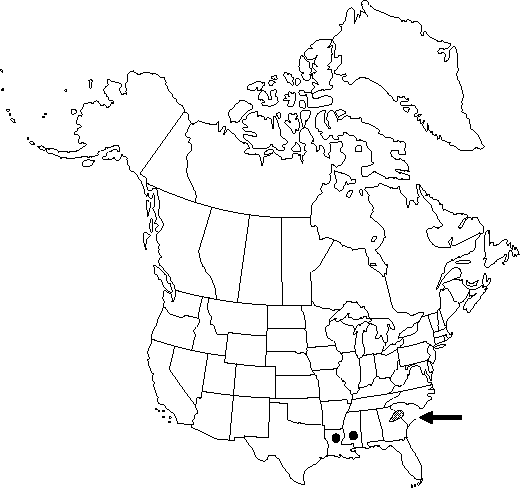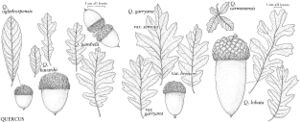Quercus oglethorpensis
Amer. Midl. Naturalist 24: 755. 1940.
Trees, deciduous, to 18 (-25) m. Bark light gray or whitish, scaly. Twigs brownish red, ca. 1 mm diam., sparsely pubescent, glabrate with age. Buds reddish-brown, globose, to 2-2.5 mm, sparsely pubescent or glabrous. Leaves: petiole 2-7 mm. Leaf-blade narrowly elliptic or oblanceolate, ± planar, not strongly convexly cupped, 50-150 × 20-45 mm, base cuneate to cordate, margins entire or on vigorous shoots sometimes sinuate near apex, secondary-veins 3-5 on each side, apex rounded, obtuse or broadly acute; surfaces abaxially yellowish green, covered with persistent velvety branched hairs, adaxially dark green, dull or glossy, sparsely stellate, often somewhat sandpapery with harsh hairs. Acorns 1-2, subsessile or on peduncle to 7 mm; cup turbinate, somewhat constricted proximally, 8 mm deep × 10 mm wide, enclosing 1/3 nut or more, scales closely appressed, finely tan-pubescent; nut gray brown, ovoid, 9-11 × (5-) 7-9 mm, finely puberulent. Cotyledons distinct.
Phenology: Flowering spring.
Habitat: Alluvial flatwoods and streamsides in rich woods, low pastures, and edge of bottomland forests
Elevation: 0-200 m
Distribution

Ga., La., Miss., S.C.
Discussion
Of conservation concern.
Since its original discovery in 1940 in Oglethorpe County, Georgia, Quercus oglethorpensis has been found to be more common locally near the type site in Georgia and South Carolina than originally thought. It remains one of the least-known oak species of the southeastern United States. Quercus oglethorpensis is one of our most distinctive eastern oaks, easily recognized by its narrow, entire, abaxially felty leaves.
Selected References
None.
